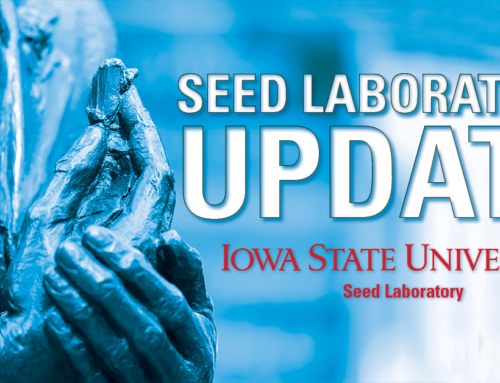

Seed Science Center Ph.D. candidate Chad Kimmelshue, and his Professor, Susana Goggi, are investigating the relationship between seed size distribution in a bag of seed and crop yield. Currently conducting their second year of field research, they are interested in analyzing how seed size and depth of planting affect seedling emergence uniformity and single plant yield. They evaluate these parameters under different field environments by using a conventional and a perennial ground cover system.
“Corn producers throughout the country are interested in assessing the effect of uneven seedling emergence on crop yield,” Goggi said. “National corn yield record-holders believe that just a few hours difference in emergence between plants may increase interplant competition and decrease yield.”
Producers speculate that seedling emergence variation may be due to a variation in seed size within a bag of seed. Some producers are testing seed size distribution within each bag they purchase and are returning to the seed dealer those bags where size distribution is too large.
The effect of uniform emergence on yield is difficult to estimate because of variation in a producer’s field conditions. Kimmelshue said most studies conducted to-date use different planting dates, growing degree days, time to 50 percent emergence, a leaf stage delay, or varying planting depth to simulate a variation in seedling emergence.
“These studies are important to understand the effects of delayed emergence, but fail to estimate interplant competition when seeds are planted on the same day and depth in a producer’s field,” Kimmelshue said. “Uniform emergence is especially important for producers adopting conservation practices such as perennial ground covers (PGC) and cover crops.”
Cover crops growing simultaneously with the cash crop are known as living mulches or PGC. New cover crop systems create new production challenges because they can change soil characteristics of the structure, temperature, organic matter content, and nitrogen availability. Understanding the effect of uneven emergence of a cash crop in a PGC and a conventional tillage system can increase crop yields and encourage producers to adopt new conservation practices such as PGC’s.
“Through our research, we are identifying optimum seed size and placement in both a conventional tillage system and a PGC system to ensure uniform emergence and maximum crop yield,” Kimmelshue said. “While producers understand the esthetic aspect of uniform emergence in their field, its effect on cash crop yield and grain composition is not fully understood.”
Kimmelshue thinks clearing up the relationship among these production challenges is essential for conservation practices adoption while harvesting high crop yield.



